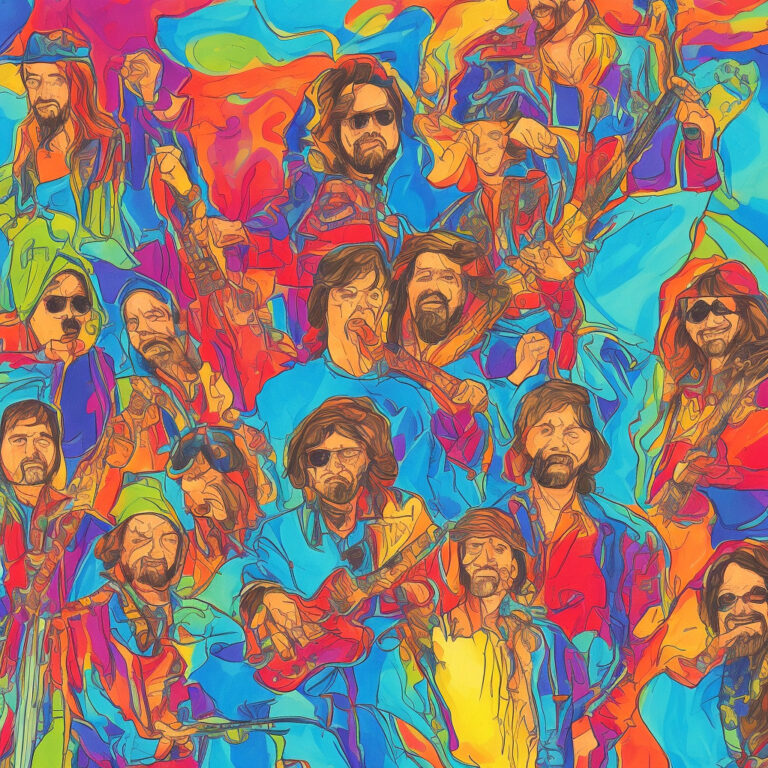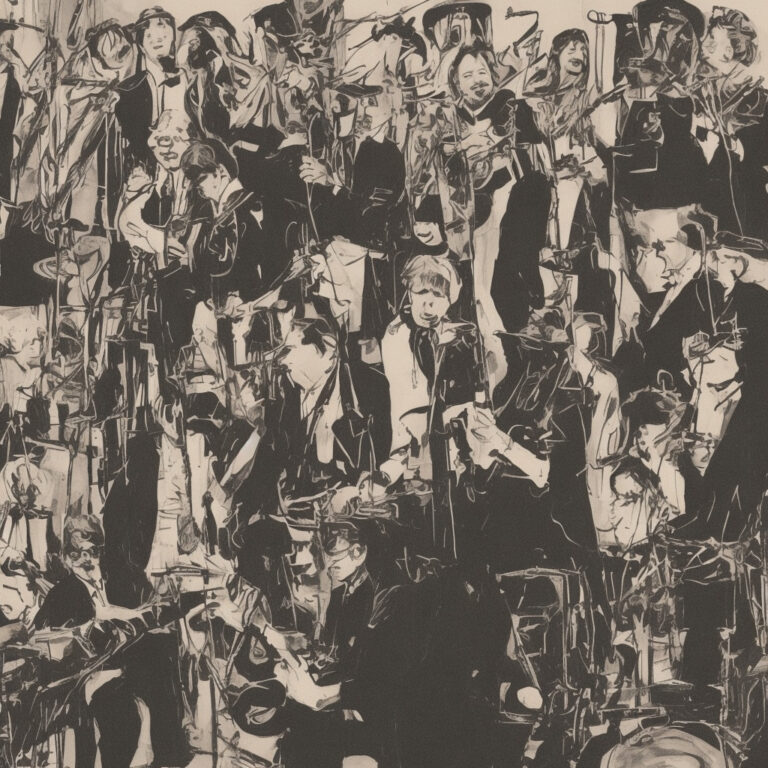? Did you know? “Takin’ It to the Streets” was The Doobie Brothers’ first hit ft. Michael McDonald on lead vocals! ? Time to groove with this timeless classic! ?✌️ #DoobieBros #MichaelMcDonald #ClassicRock #FunFact Read about it: tinyurl.com/3jy48k6a
Revolutionizing Classic Rock with Soulful Tunes: The Doobie Brothers
Doobie Brothers: Classic rock icons, continually evolving with soulful tunes, adapting to the ever-changing music landscape, and earning their place in the Rock and Roll Hall of Fame.

The Doobie Brothers, a renowned classic rock band formed in 1970, have captivated music lovers for decades with their unique blend of rock, soul, and funk. With a continually evolving lineup and sound, the group has managed to stay relevant in the ever-changing musical landscape.
One of the standout tracks in their extensive discography is “Takin’ It to the Streets,” released in 1976. This song marked a significant turning point for the band as it introduced Michael McDonald as a new member, who contributed his distinctive, soulful voice and keyboard skills. His incorporation breathed new life into The Doobie Brothers’ sound, steering it towards a more soulful and melodic direction.
While the band’s earlier work was characterized by lead vocalist Tom Johnston’s powerful voice and guitar-driven tunes, McDonald’s arrival brought a softer, more R&B-influenced touch to their music. The success of “Takin’ It to the Streets” propelled the band to new heights, solidifying their position in the music industry and earning them legions of devoted fans.
Throughout their career, The Doobie Brothers have maintained an ever-changing lineup, with members such as Tom Johnston, Michael McDonald, Pat Simmons, Jeff “Skunk” Baxter, and John McFee, among others. This constant evolution has led to a diverse and dynamic sound, with each member leaving their indelible mark on the music.
Although The Doobie Brothers have enjoyed immense success, they have not been without their fair share of challenges. For instance, the group disbanded in 1982 due to creative differences, only to reunite five years later. Additionally, the constant shifts in lineup have at times led to inconsistency in their musical output. However, fans have remained loyal, appreciating the band’s willingness to experiment and redefine their style.
Over the years, The Doobie Brothers have received numerous accolades, including four GRAMMY Awards and being inducted into the Vocal Group Hall of Fame. In 2020, the band’s enduring contributions to the music industry were recognized with their long-awaited induction into the prestigious Rock and Roll Hall of Fame.
With a legacy spanning five decades and counting, The Doobie Brothers have proven their ability to evolve and adapt while staying true to their roots. Despite the occasional misstep, their dedication to delivering timeless music has solidified their status as one of the most successful and influential bands in classic rock history.
Charting the Streets
Soulful sound meets chart-topping success: “Takin’ It to the Streets” solidifies The Doobie Brothers’ legacy with its infectious energy and international appeal.

Released as a single on March 19, 1976, “Takin’ It to the Streets” became an instant hit for The Doobie Brothers. Following its release, the song quickly climbed the charts as fans and critics alike were captivated by its soulful sound and evocative lyrics.
Upon its debut, “Takin’ It to the Streets” entered the US Billboard Hot 100 chart at an impressive No. 79, showcasing the public’s eagerness for fresh, new material from the band. Over the next few weeks, the song continued its upward trajectory, fueled by radio airplay and word-of-mouth from dedicated fans. Eventually, the single reached its peak position at No. 13, solidifying its status as a successful track for The Doobie Brothers.
Not only did “Takin’ It to the Streets” make its mark on the US charts, but it also gained traction in international markets. In Canada, the song landed on the RPM Top Singles chart, peaking at a respectable No. 7. This further demonstrated the band’s widespread appeal and the song’s ability to resonate with audiences outside of their home country.
In addition to its chart success, “Takin’ It to the Streets” has also become a staple in The Doobie Brothers’ live performances. The song’s infectious energy and memorable chorus have made it a fan-favorite, ensuring its longevity and enduring appeal.
While “Takin’ It to the Streets” may not have reached the top of the charts, its impact on The Doobie Brothers’ career and the music landscape of the 1970s cannot be understated. The song’s chart performance is a testament to the band’s ability to captivate audiences with their innovative sound and lyrical prowess.
Unraveling the Lyrics: A Journey Through Time
You don’t know me but I’m your brother
I was raised here in this living hell
You don’t know my kind in your world
Fairly soon, the time will tell
You, telling me the things you’re gonna do for me
I ain’t blind and I don’t like what I think I see
Takin’ it to the streets
Takin’ it to the streets
Takin’ it to the streets
No more need for running
Takin’ it to the streets
An iconic song from The Doobie Brothers’ 1976 album of the same name, “Takin’ It to the Streets” perfectly captures the spirit and turmoil of the era it was written in. This song was penned during a time when the United States was witnessing significant social change, following the civil rights movement, anti-war protests, and a general atmosphere of unrest.
The lyrics, written by Michael McDonald, who also took over as the lead vocalist for this track, delve into themes of social justice and solidarity, encouraging listeners to take action and make their voices heard. The opening lines, “You don’t know me but I’m your brother” and “You don’t know my kind in your world,” seem to address the divisions and misunderstandings that plagued society at the time.
The chorus, “Takin’ it to the streets,” is a rallying cry for change, inspiring people to come together and fight for what they believe in rather than sitting idly by. The line, “No more need for running,” implies that the time had come to face issues head-on and work collectively to find solutions.
The song’s appeal doesn’t stop at its lyrics, though. Its blend of rock, soul, and R&B effortlessly complements the powerful message conveyed through the words. The infusion of gospel influences, with the use of a Hammond B3 organ and soulful backing vocals, further reinforces the call to action and unity.
In conclusion, “Takin’ It to the Streets” by The Doobie Brothers remains a relevant and impactful anthem for social change, even decades after its release. The song’s powerful lyrics, combined with its soulful and innovative musical composition, show the band’s commitment to using music as a tool for addressing important issues and unifying listeners during turbulent times.
A Walk Down Memory Lane: The Video for “Takin’ It to the Streets”
Fan-made visuals and diverse covers breathe new life into The Doobie Brothers’ timeless classic “Takin’ It to the Streets,” uniting generations with its message of unity and empowerment.
While “Takin’ It to the Streets” by The Doobie Brothers doesn’t have an official music video, that hasn’t stopped fans from creating their own visual interpretations of the track. Since its release in 1976, the uplifting song has inspired various fan-made videos, YouTube tributes, and montages that showcase not only the band’s infectious energy but also its impact on generations of listeners.
One notable fan video combines clips from the band’s live performances with dynamic visuals, giving viewers a taste of the electrifying atmosphere of a Doobie Brothers concert. Other videos have taken a more nostalgic route, featuring photographs of the band throughout their career, as well as images of album covers and promotional materials, illustrating the evolution of the band’s image.
On a more personal level, some fans have created their own tributes to “Takin’ It to the Streets” by compiling clips of themselves and their friends singing and dancing along to the track. These videos not only show the power of music to bring people together but also highlight how a song can continue to resonate with listeners more than four decades after its release.
The Doobie Brothers’ enduring appeal is also evident in the numerous covers and remixes of “Takin’ It to the Streets” that can be found online. From smooth jazz renditions to electronic reimaginings, the song’s message of unity and empowerment has been reinterpreted by a diverse array of artists and producers, proving that its influence transcends genres and generations.
So even without an official music video, “Takin’ It to the Streets” has inspired a wealth of visual content that showcases the song’s enduring legacy and enduring appeal. The Doobie Brothers’ timeless classic continues to unite fans across the globe, proving that sometimes, all it takes is a great song to bring people together.
The Mastermind Behind “Takin’ It to the Streets”
The genius composer of “Takin’ It to the Streets” is none other than Michael McDonald, who joined The Doobie Brothers in 1975 as a keyboardist and lead vocalist. This talented musician has contributed his songwriting prowess to several other notable hits of the band, such as “What a Fool Believes” and “Minute by Minute.” Before joining the Doobie Brothers, McDonald was a member of Steely Dan, where he contributed backing vocals to their albums “Katy Lied” and “The Royal Scam.” Over the years, McDonald has collaborated with numerous prominent artists, including Carly Simon, Christopher Cross, Kenny Loggins, and Patti LaBelle, solidifying his status as a prolific and sought-after composer in the music industry.
Accolades, Appearances, and Cover Versions
From Billboard charts to TV series and movie soundtracks, The Doobie Brothers’ timeless hit “Takin’ It to the Streets” transcends generations and genres, solidifying its iconic status in music history.

“Takin’ It to the Streets,” a soulful and powerful hit by The Doobie Brothers, has received various accolades and recognitions since its release as the lead single from the band’s 1976 album of the same name. Featuring Michael McDonald on vocals, the song’s popularity and influence led to it peaking at number 13 on the Billboard Hot 100 chart. This successful single shone a spotlight on McDonald’s soulful vocal talents and The Doobie Brothers’ seamless transition from their earlier rock sound to a more R&B and funk-infused style.
Over the years, “Takin’ It to the Streets” has been featured in various forms of media, further solidifying its impact on pop culture. The song appeared in a 2005 episode of the hit TV series “The Sopranos,” during which the character Tony Blundetto played the track on a jukebox. Additionally, in the 2019 film “Captain Marvel,” the song was included in the movie’s immersive 1990s soundtrack, exposing it to a new generation of listeners.
As with many influential tracks, “Takin’ It to the Streets” has inspired a number of celebrated cover versions. In 1995, the R&B/pop group, Take 6, recorded a cover of the song featuring McDonald himself. This collaboration resulted in a Grammy Award nomination for Best R&B Performance by a Duo or Group with Vocals. Moreover, in 2006, soul singer Will Downing released a version of the song on his album “Soul Symphony.” Other notable covers have been performed by various artists from different genres, showcasing the song’s timeless appeal and versatility.
In conclusion, the lasting impact of “Takin’ It to the Streets” is evident through its numerous recognitions, media appearances, and cover versions produced over time. The song’s success goes far beyond the charts and the band’s discography, with its influence reaching across generations and genres, proving that The Doobie Brothers’ classic hit remains a true cornerstone of American music history.
Breaking Down the Musical Elements
Diving into the musical structure of “Takin’ It to the Streets,” it’s essential to note that this song is written in the key of C major. As a result, the chords primarily consist of C, F, and G, which are the I, IV, and V chords in the key. The harmonic structure is quite straightforward, with the verse following a I-IV-V progression, and the chorus using a I-IV-I-V sequence. The simplicity of the chord progression allows for the melody and lyrics to take center stage, making it an easily memorable and catchy tune.
The tempo of the song is set at a moderate 96 beats per minute (BPM). This tempo gives the track a laid-back and groovy feel, perfectly complementing the smooth vocal delivery and the overall theme of the song. The rhythm section, consisting of drums, bass, and percussion, provides a steady and infectious beat that drives the track forward.
One of the stand-out features of “Takin’ It to the Streets” is the use of syncopation throughout the song. Syncopation, in this case, refers to the deliberate shifting of the rhythmic emphasis from the strong beats to the weak beats, creating a sense of anticipation and excitement. This technique is particularly evident in the piano and guitar parts, as well as the vocal melody, giving the track its signature funky feel.
The arrangement of the song also deserves some attention. The Doobie Brothers skillfully utilize a rich and diverse instrumentation, including electric guitars, keyboards, horns, and a variety of percussion instruments. The horns, in particular, play a significant role in establishing the song’s soulful vibe, as they punctuate the chorus with powerful and uplifting bursts of sound.
Another remarkable aspect of “Takin’ It to the Streets” is the use of harmony, both in the instrumentation and the vocals. The backing vocals are arranged in a tight three-part harmony, with the lead vocalist often joining in on the choruses to create a lush and full sound. This harmonization adds depth and richness to the track, further enhancing its overall impact.
In summary, “Takin’ It to the Streets” by The Doobie Brothers showcases a perfect blend of catchy melody, groovy rhythm, and intricate harmony, all bound together by a solid and straightforward chord progression. The band’s meticulous attention to detail in the arrangement and instrumentation elevates the song from a simple tune to an unforgettable classic that continues to resonate with listeners even decades after its release.







